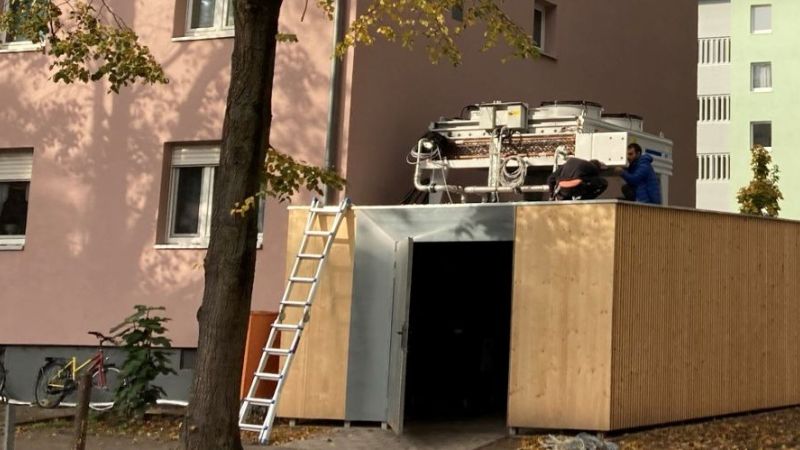 © Nikolaus Heiss
© Nikolaus Heiss
Energy-efficient Unicampus
TU Darmstadt networks electricity, heating and cooling
For its Campus Lichtwiese, the Technische Universität Darmstadt is aiming to realise the energy transition in an exemplary fashion at the district level through intelligently linking the building modernisation and future energy supply, whereby long-term structural and social changes shall also be taken into account. The project is being used both for illustrative purposes and as a working environment for an interdisciplinary research team.
The realisation of Germany’s Energiewende – its energy transition – requires the use of innovative technologies, especially in the energy supply, load management and decentralised storage fields – not only in the large-scale context but also in the district context. In the coming years, TU Darmstadt is aiming to significantly increase the energy efficiency on all its campus sites. This covers all areas, ranging from the modernisation of buildings and the thermal and electrical energy provision to the information-based connection of all subsystems. An interdisciplinary research team comprising architects (Design and Sustainable Building Unit), electrical engineers (Electrical Power Supply Using Renewable Energies Unit), mechanical engineers (Technical Thermodynamics Unit) and computer scientists (Programming Distributed Systems Unit) is focussing on these aspects. They want to show how an overall concept for an energy-efficient campus can be developed simultaneously and integratively in an interdisciplinary manner.
Research focus
Based on TU Darmstadt’s Campus Lichtwiese, the project aims to demonstrate how the use of innovative approaches and technologies from different research areas can establish an overall concept for an energy-efficient campus that aims to optimise all energy sectors and their mutual interactions. The increase in energy efficiency is based on reducing the total energy consumption and CO2 emissions while increasing the proportion of self-generated energy through intelligent operational planning and the networking of existing generation and storage capacities (coupling of electrical networks – thermal networks – buildings). This is to reduce the energy drawn from the public grid.
Campus Lichtwiese is particularly suitable as a study object for investigating districts. It has the following features: The 40-plus buildings (108,000 m² of usable area) form a clearly defined space. The campus is separated from the surrounding urban realm by open spaces. In terms of ownership and planning legislation it forms a single entity and has a variety of different functions. Campus Lichtwiese can therefore be regarded as a largely independent unit. Existing networks with other sites and superordinate energy networks can be controlled. This also makes it easier to investigate this unit in terms of the energy balancing. Being a single entity in terms of the ownership and planning legislation aspects provides an essential prerequisite for an accelerated change in the energy supply. As an autonomous model university, TU Darmstadt is in the unique situation of being able to make all essential construction decisions independently and therefore make changes more quickly. The mixture of uses on the campus not only includes campus-type functions such as offices, laboratories, lecture theatres and libraries but also production-based test facilities. A later enlargement with residential buildings and facilities for providing everyday amenities is also planned.
Campus Lichtwiese has its own energy centre, a cogeneration plant that supplies the campus with heat and electricity. It consists of three CHP units, each with a 1.95 MW electrical and 2.0 MW thermal capacity, as well as six gas-fired boilers for additional heat generation with a total thermal capacity of 55.8 MW. All the facilities are under single ownership. The cogeneration plant will also be operated by a contractor (energy supplier) during the next 15 years. The university buildings currently receive about two thirds of their electrical energy from the electricity self-generated by the CHP units. Approximately a third of the electricity is supplied from the upstream public grid. The heat is supplied to the university by a separate, more than 40-year-old district heating network that is configured for a CHP-based supply temperature of up to 110 °C. A cooling network is currently only available decentrally for a few building units.
The energy concept being developed is based on the following four cornerstones:
- Increasing energy efficiency through intelligent networking of the energy supply systems for electricity, heating and cooling (coordinated construction and operational management strategies between the energy supply and buildings)
- Developing long-term efficiency concepts through forward-looking planning (inclusion of structural and social changes) and a campus-wide monitoring strategy for recording the generation and consumption and assessing efficiency
- Expanding the share of cogeneration by integrating thermal storage and using the storage potential provided by district heating networks and buildings as well as using thermal energy for generating cooling energy by means of absorption chillers
- Developing a concept for collecting, disseminating and processing data for monitoring and influencing the existing energy infrastructures
Optimisation
For modelling an efficient electrical and thermal network, the measures for increasing the energy efficiency and modernising the university buildings provide necessary input parameters for future consumption changes. Coordination is achieved by suitably transferring the load profiles, either based on complete annual load graphs or by means of selected reference weeks with seasonal differences and a 15-minute interval size.
Since the electrical and thermal networks mutually influence each other via a series of components that includes the CHP units, storage systems and absorption chillers, the concept development for the thermal supply needs to be carried out in close coordination with the electrical networks. Conversely, information about the interfaces to the thermal networks in accordance with the different thermal supply concepts is necessary for optimising the electrical networks. This includes information on the rated powers, time constants, storage capacities and seasonal dependencies.
Economic feasibility
One of the work packages focuses on the economic feasibility. This is concerned with concepts with different focuses, including the energy efficiency, high provision of renewable energy, optimised operation of the CHP units, etc.










